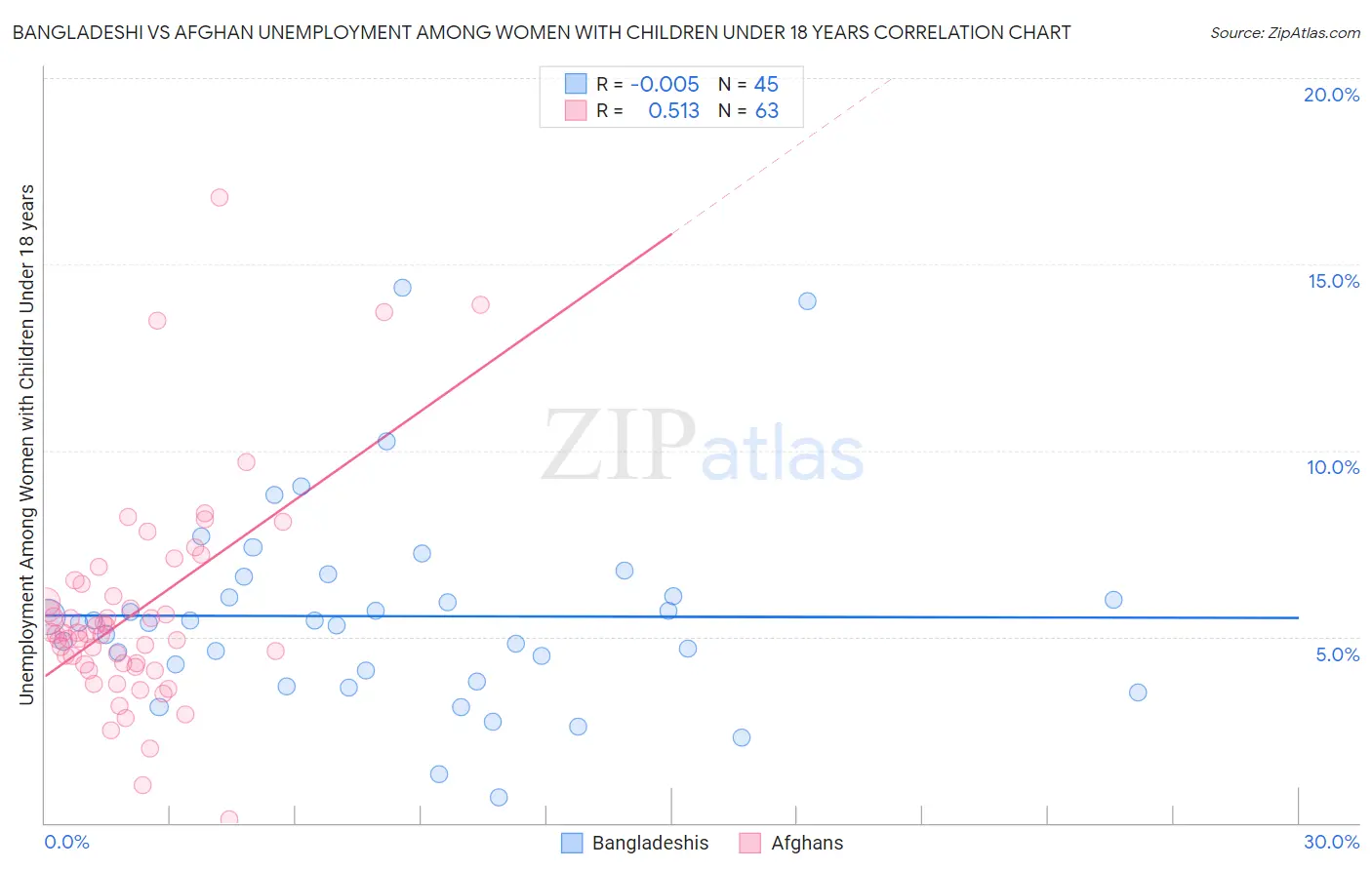Bangladeshi vs Afghan Unemployment Among Women with Children Under 18 years
COMPARE
Bangladeshi
Afghan
Unemployment Among Women with Children Under 18 years
Unemployment Among Women with Children Under 18 years Comparison
Bangladeshis
Afghans
5.3%
UNEMPLOYMENT AMONG WOMEN WITH CHILDREN UNDER 18 YEARS
73.2/ 100
METRIC RATING
147th/ 347
METRIC RANK
5.4%
UNEMPLOYMENT AMONG WOMEN WITH CHILDREN UNDER 18 YEARS
66.6/ 100
METRIC RATING
160th/ 347
METRIC RANK
Bangladeshi vs Afghan Unemployment Among Women with Children Under 18 years Correlation Chart
The statistical analysis conducted on geographies consisting of 138,843,542 people shows no correlation between the proportion of Bangladeshis and unemployment rate among women with children under the age of 18 in the United States with a correlation coefficient (R) of -0.005 and weighted average of 5.3%. Similarly, the statistical analysis conducted on geographies consisting of 147,488,552 people shows a substantial positive correlation between the proportion of Afghans and unemployment rate among women with children under the age of 18 in the United States with a correlation coefficient (R) of 0.513 and weighted average of 5.4%, a difference of 0.56%.

Unemployment Among Women with Children Under 18 years Correlation Summary
| Measurement | Bangladeshi | Afghan |
| Minimum | 0.70% | 0.10% |
| Maximum | 14.4% | 16.8% |
| Range | 13.7% | 16.7% |
| Mean | 5.5% | 5.7% |
| Median | 5.4% | 5.1% |
| Interquartile 25% (IQ1) | 3.9% | 4.2% |
| Interquartile 75% (IQ3) | 6.4% | 6.4% |
| Interquartile Range (IQR) | 2.4% | 2.2% |
| Standard Deviation (Sample) | 2.7% | 2.9% |
| Standard Deviation (Population) | 2.6% | 2.9% |
Demographics Similar to Bangladeshis and Afghans by Unemployment Among Women with Children Under 18 years
In terms of unemployment among women with children under 18 years, the demographic groups most similar to Bangladeshis are Immigrants from Belarus (5.3%, a difference of 0.020%), Immigrants from Western Europe (5.4%, a difference of 0.030%), Immigrants from Egypt (5.3%, a difference of 0.070%), Immigrants from Kenya (5.4%, a difference of 0.090%), and Immigrants from Argentina (5.4%, a difference of 0.13%). Similarly, the demographic groups most similar to Afghans are Immigrants from Iraq (5.4%, a difference of 0.050%), Immigrants from Saudi Arabia (5.4%, a difference of 0.12%), Chickasaw (5.4%, a difference of 0.15%), Lebanese (5.4%, a difference of 0.15%), and Immigrants from Burma/Myanmar (5.4%, a difference of 0.24%).
| Demographics | Rating | Rank | Unemployment Among Women with Children Under 18 years |
| Chileans | 75.0 /100 | #143 | Good 5.3% |
| Immigrants | England | 74.9 /100 | #144 | Good 5.3% |
| Immigrants | Egypt | 74.0 /100 | #145 | Good 5.3% |
| Immigrants | Belarus | 73.4 /100 | #146 | Good 5.3% |
| Bangladeshis | 73.2 /100 | #147 | Good 5.3% |
| Immigrants | Western Europe | 72.8 /100 | #148 | Good 5.4% |
| Immigrants | Kenya | 72.2 /100 | #149 | Good 5.4% |
| Immigrants | Argentina | 71.7 /100 | #150 | Good 5.4% |
| Immigrants | Iran | 71.1 /100 | #151 | Good 5.4% |
| Immigrants | South Eastern Asia | 71.1 /100 | #152 | Good 5.4% |
| Carpatho Rusyns | 70.8 /100 | #153 | Good 5.4% |
| Immigrants | Latvia | 70.8 /100 | #154 | Good 5.4% |
| Koreans | 70.5 /100 | #155 | Good 5.4% |
| South Africans | 70.3 /100 | #156 | Good 5.4% |
| German Russians | 70.2 /100 | #157 | Good 5.4% |
| Immigrants | Burma/Myanmar | 69.5 /100 | #158 | Good 5.4% |
| Chickasaw | 68.4 /100 | #159 | Good 5.4% |
| Afghans | 66.6 /100 | #160 | Good 5.4% |
| Immigrants | Iraq | 65.9 /100 | #161 | Good 5.4% |
| Immigrants | Saudi Arabia | 65.0 /100 | #162 | Good 5.4% |
| Lebanese | 64.7 /100 | #163 | Good 5.4% |